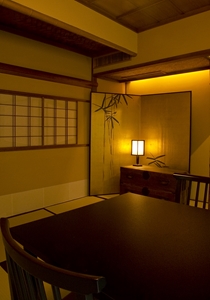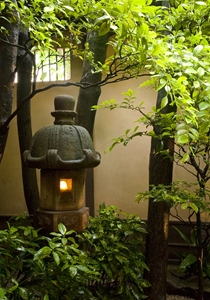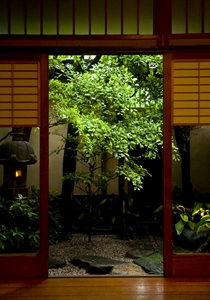Flowing with the winds of change

Times inevitably bring society changes, and the once important ryotei, the place for important and discreet, but lavish and luxurious political and business meetings, had to adapt in order to survive. And Kawabun successfully achieved that. Nowadays anyone is able to enter the glamorous shop, opposite of olden times when being introduced by an already known customer was a requirement to enter the premises, and payments were made in the month’s end by invoice.
The origins as fish shop
When Tokugawa Ieyasu ordered the “Kiyosu-Goshi” (lit. “Kiyosu Moving”), the big moving of the whole castle and city of Kiyosu to the current Nagoya site, merchants of a same line of trade were required to orderly settle near each other in the same street in Nagoya. Kawabun’s founder Kawachiya Bunzaemon then established himself at the current shop’s location, together with other fish merchants, at the street that even now is adequately called “Uodana-dori” Street (lit. “Street of the Shelves of Fish”).

It started as a simple fish shop that sold fresh river and, supposedly, sea produce. Bunzaemon, upon gaining recognition from elite members such as Tokugawa Ieyasu himself for having a good eye for the trade, was able to become a supplier to the catering needs of the Tokugawa clan, after being ordered to “bring those fish cooked to Nagoya Castle”. Thus casually started the Kawabun catering business, which makes impossible to define the date when customers started to be served and eat there.

Photo: Kawabun was an appointed Tokugawa Clan caterer and has a history that interweaves with that of Nagoya Castle itself. Among the many legends around these two institutions is of the well in Kawabun’s garden. It is believed that a tunnel connects it to the castle’s well, and in case of emergencies, would be used as escape route for the castle’s residents.
The VIP meeting place of choice, burnt to ashes by air raids

During the enlightening days of the Meiji era, the refined Kawabun became the place of choice for VIP gatherings, and in the period afterwards was graced by the presence of big Japanese and foreign names such as Prince Ito Hirobumi, who was the first ever Prime Minister of Japan, former Prime Ministers Shigeru Yoshida and Kakuei Tanaka, and France President François Mitterrand, not to mention the constant clientele of local politicians and prominent businessmen.

But the special status of Kawabun wouldn’t shield it against the indiscriminating incendiary air raid bombs that laid waste to Nagoya, and as with the rest of the city, the original Kawabun building was consumed by fire in the final days of WW2. Between 1950 and 1952, a reconstruction took place by obeying the exact engineering style of the previous building, a feat rewarded in 2004 when it was appointed as Registered National Tangible Cultural Asset.

Photo: The panel with the golden-plated three-leaf mallows of the Tokugawa Clan crest is believed to have decorated the entrance of Nagoya Castle itself, and somehow found its way to the shop’s premises. Its relatively new appearance owns to an inebriated VIP customer who accidentally stumbled on it, toppling and damaging the precious piece. The mortified client profusely apologized and promised to repair it, regardless of the cost. The beautifully repaired piece decorates the shop’s corridors to this day.
Collaboration by an uprising world-class architect

In 1971 Kawabun took the challenge to modernize part of its installations with the help of Yoshiro Taniguchi, the famous architect recognized by his works in the Main Lobby of the Hotel Okura Tokyo and the Imperial Theatre. He designed the “Mizukagami-no-ma”, or Water Mirror Place, to replace the inner Japanese garden. The audacious art project was helped by local big corporations such as construction giant Shimizu Kensetsu and tool maker Yamazaki Mazak.

Predictably enough, the innovation wasn’t welcomed by all. A well-cared inner garden is a prerequisite of a ryotei, and replacing it with a cold, straight-lined pool of granite and concrete generated a lot criticism and dismay from the more purist clients. However, the modern rectilinear design and the prolific use of the “Asa-no-ha” flax leaf motifs, together with Taniguchi’s posterior acclaim, put a definitive end to any debate: the design was a true expression of Japan’s ever changing design trends and fit for a ryotei.

Photo: The architectural style of Yoshiro Taniguchi is known to be practical, clean and stylish. However, applying such a style on a ryotei in the Japan of 45 years ago was a rather bold move that surprisingly demonstrates how Kawabun successfully achieved to predict avant-garde tendencies outside of the gastronomical scope, but that nonetheless greatly impacted its “Omotenashi” principles. The corridors, the Banquet Hall and the Water Mirror are functional, stunning pieces of architectural design carefully planned to entertain and match the existing constructions.

Photo: The large Castanopsis tree at the back of the Water Mirror pool is believed to be roughly the same age of Nagoya, being planted by the castle’s engineers in order to mark cardinal reference points around the terrain that, back then, was a plain area that had no distinguishable features anywhere to be seen. Usually, such trees would be cut away upon finishing the construction, but Nagoya Castle’s trees weren’t. Of the four trees, Kawabun’s tree marks the south point. A large Camphor tree still existent in Shumoku-cho by the Route 41, marks the east of the castle, and the other two - for north and west - were cut much later after the castle was finished.
Preserving the artistic sense to endure for generations
Kawabun’s architectural appeal has an artistic touch that simply won’t stop bearing fruit. As renowned sculptor Masayuki Nagare commented on the water mirror as looking “somewhat desolate by itself”, he contributed by adding the central stone deck “Nagare-doko-no-niwa” monument. The stunning arrangement is thus result of a collaboration work of two world-class Japanese specialists, something quite rare to see elsewhere.

Photo: People familiar with the ryotei concept will find it quite surprising, but at Kawabun you don’t take your shoes off. Trotting shoes-on around the somewhat delicate wooden floors feels unnatural at first, and the shop took a bit of bashing for this, but once you understand that the new standard is part of a non-barrier design effort of Omotenashi aimed at facilitating the access by handicapped clients who use wheelchair, crutches or cane, and which includes the use of chairs instead of sitting at the floor – sitting on the floor is challenging for elder people - it becomes a rather acceptable new norm.

Photo: Kawabun is always adapting to the new modern lifestyles. So in order to serve a younger generation of patrons not familiar with the old ryotei traditions, the shop now has the “Kawachiya”, an over-the-counter “kappo cuisine” section where you can casually enter and have a good conversation with the highly skilled cook on duty. There’s also the Tea Ceremony Room that doubles as café and tea house during the day and Pub at night, and other less perceptible changes, such as the current fancy lady’s rooms, as in the past it was unthinkable that women would ever enter a ryotei.

Good old traditions continuously mixed with the newest styles. The unbeknownst depth of the “ryotei” culture with the unexpected series of innovative challenges took us by surprise. What Kawabun keeps in store for us as part of its constant evolution is something we want to keep experiencing personally as it goes imprinting its mark on this city’s history.







































 KEYWORD
KEYWORD 






